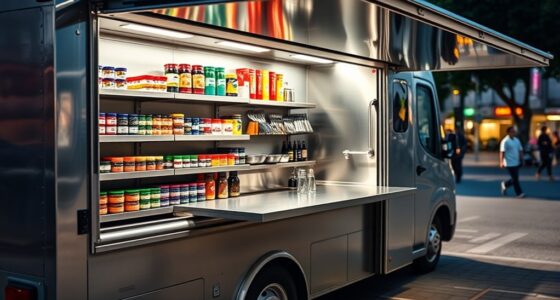Managing food truck logistics differs markedly between urban and rural areas. In cities, you’ll need to navigate strict permits, optimize limited parking, and engage high foot traffic with strategic placement and marketing. Rural areas demand flexible scheduling, community involvement, and targeted outreach. Both require efficient scheduling, inventory control, and tailored staffing. By understanding these distinct needs, you can streamline operations and boost success in any environment—keep exploring to uncover essential tips for each setting.
Key Takeaways
- Urban areas require detailed permit management, parking strategies, and space optimization for high visibility and compliance.
- Rural locations benefit from flexible permits, community engagement, and targeted marketing to attract customers with fewer restrictions.
- Urban food trucks should focus on high foot traffic sites and dynamic staffing for busy periods, leveraging digital branding.
- Rural food trucks need strategic placement, local partnerships, and adaptable staffing to maximize outreach and operational efficiency.
- Both environments demand tailored logistics planning, including supply chain management, event scheduling, and regulatory adherence.
Navigating Permitting and Regulations in Different Settings

Understanding permitting and regulations can be challenging because requirements vary widely depending on the location and setting. In urban areas, you’ll face strict permits compliance, often involving multiple agencies overseeing health, safety, and zoning. These regulation hurdles can delay your launch and increase costs. Rural settings tend to have fewer restrictions, but you still need to guarantee you meet local health codes and obtain necessary permits. It’s essential to research specific rules early, as non-compliance can lead to fines or shutdowns. Keep detailed records of all permits and inspections, and stay updated on any regulation changes. Being aware of building codes and zoning regulations can help you ensure your tiny house or food truck setup remains compliant throughout the process. Moreover, familiarizing yourself with regulatory trends from recent data can help anticipate upcoming changes. Additionally, understanding the permitting process in your area can significantly reduce setup delays and streamline your operations. Developing an understanding of local health department requirements can further aid in maintaining ongoing compliance and avoiding unexpected issues. For example, staying informed about technology updates in regulatory practices can give you a competitive edge and facilitate smoother approvals.
Parking and Space Management Strategies
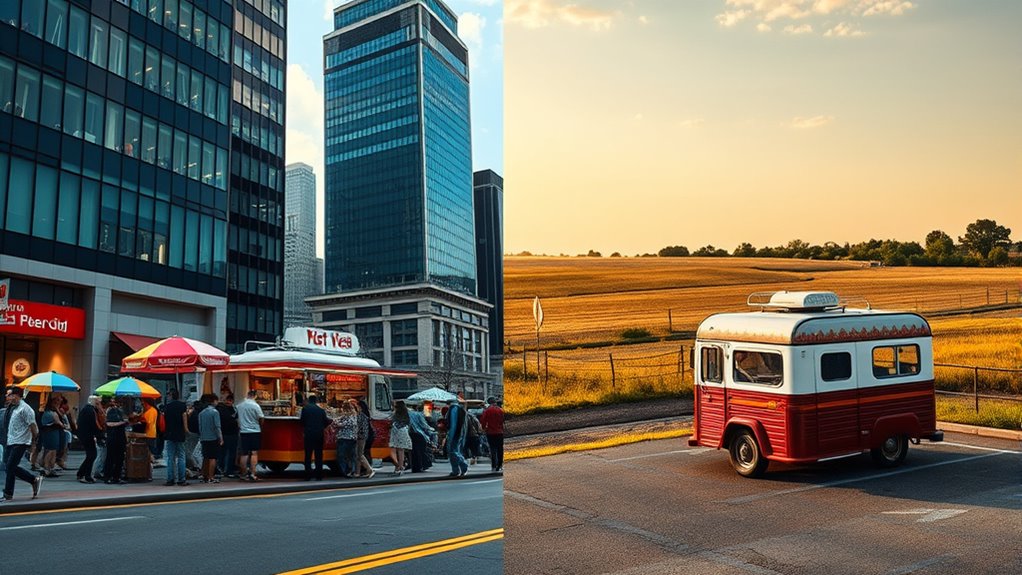
Effective parking and space management are crucial for maximizing your food truck’s visibility and operational efficiency. In urban areas, parking challenges often include limited spaces and strict regulations, so you must prioritize space optimization. Look for high-traffic zones where your truck can attract maximum customers without causing congestion. Use clear signage and designated spots to streamline parking and avoid fines or disruptions. In rural areas, space constraints are less severe, but you still need to plan for essential placement to reach your target audience. Consider local parking rules and available space to prevent overlaps or unsafe setups. Whether in urban or rural settings, proactive space management ensures your truck remains accessible, visible, and compliant, ultimately boosting your sales and reputation. Additionally, understanding city dynamics can help you choose optimal locations that align with your business goals.
Customer Engagement and Foot Traffic Considerations
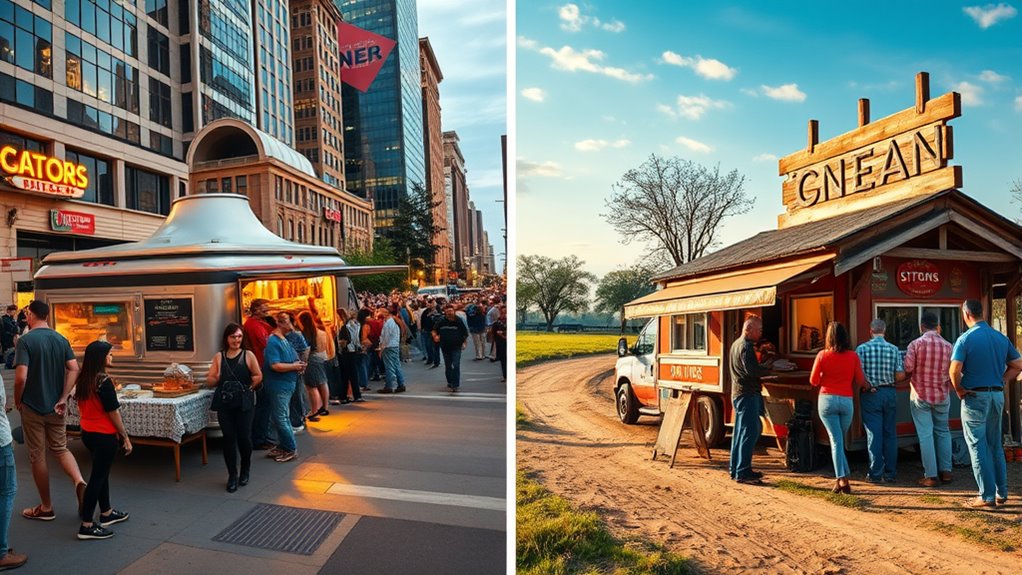
Understanding your target location is key to attracting customers. In urban areas, high foot traffic can boost your visibility, but rural settings require different engagement strategies. Tailoring your approach guarantees you connect with your audience and maximize your truck’s potential. Incorporating eye patch benefits into your marketing or branding can also create memorable impressions and differentiate your food truck from competitors. Recognizing the importance of customer engagement strategies can further enhance your success in diverse environments. Additionally, adapting your logistics management to local conditions ensures smooth operations whether in city or countryside. Employing space optimization techniques such as vertical storage solutions can help maximize limited urban space, while in rural settings, creating designated zones can streamline your operations and improve efficiency.
Urban Area Foot Traffic
Urban area foot traffic plays a crucial role in attracting customers and maximizing sales for your food truck. High residential density and well-developed urban infrastructure create bustling environments where people naturally gather. To capitalize on this, position your truck in areas with high foot traffic, such as near transit stations, office buildings, or popular gathering spots. Understanding pedestrian flow helps you choose locations with consistent activity, increasing your chances of repeat customers. Additionally, engaging with the local community and utilizing visible signage can boost visibility amid busy streets. Keep in mind that urban areas often have diverse crowds, so offering a variety of menu options can cater to different tastes. By leveraging high-density zones and urban infrastructure, you optimize your food truck’s engagement potential. Recognizing the importance of Self Watering Plant Pots are another example of how thoughtful design enhances functionality in busy environments. Incorporating filtration systems into your setup can also help maintain cleanliness and hygiene in areas with high traffic. Recognizing the importance of skincare patches in daily routines demonstrates how small, targeted solutions can improve overall efficiency and results. Understanding how essential oils for respiratory health can create a more comfortable environment for staff and customers may also contribute to better customer experience. Additionally, using knowledge about nutritional advantages of juices can inspire menu items that appeal to health-conscious customers.
Rural Engagement Strategies
While rural areas often have lower foot traffic than cities, you can still successfully engage customers by focusing on strategic placement and community involvement. Use digital marketing to target local audiences through social media, community groups, and local event updates. Building relationships through community outreach helps establish trust and loyalty, encouraging repeat visits. Consider partnering with local organizations or participating in community events to boost visibility. Tailor your messaging to resonate with local values and interests, making your food truck a familiar, welcome presence. Additionally, leveraging community engagement principles like strategic planning and outreach can help you adapt your efforts effectively. Integrating predictive analytics can further optimize your marketing efforts by understanding customer behaviors and preferences. Employing AI security techniques such as behavioral analytics can help you identify emerging community trends and respond proactively. By combining smart digital marketing strategies with active community engagement, you can increase foot traffic and foster strong customer relationships, even in areas with fewer passersby. Moreover, understanding local market demand can guide your menu offerings and promotional activities to better meet customer needs.
Event Participation and Scheduling Tactics
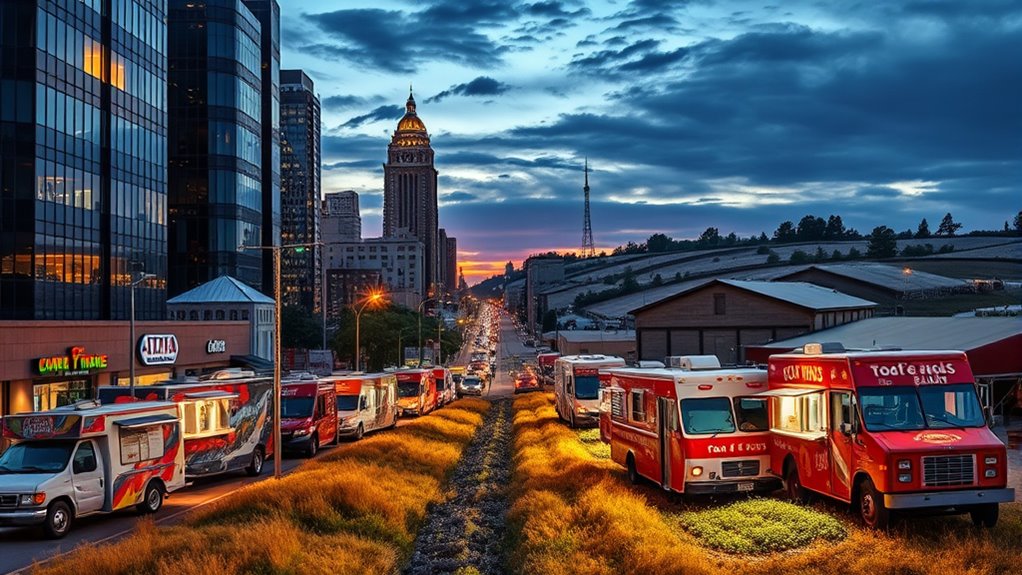
Choosing the right event timing can make or break your success, so plan your schedule around peak attendance periods. Selecting venues that align with your target audience guarantees maximum exposure and sales. Coordinating with event organizers early helps you secure ideal spots and avoid last-minute conflicts. Incorporating effective wall organization strategies can also optimize your setup and ensure a smooth operation during busy events. Additionally, considering the nutrient content of juices served at your truck can attract health-conscious customers and differentiate your offerings. Being aware of cost-effective services available in your area can also help you manage expenses without compromising quality.
Event Timing Strategies
Effective event timing is essential for maximizing your food truck’s visibility and sales. By selecting ideal times, you can boost catering partnerships and ensure equipment runs smoothly. Focus on these key tactics:
- Schedule events during peak hours—lunch or dinner—to attract more customers.
- Coordinate with local events and festivals to align your truck’s presence for increased exposure.
- Regularly maintain equipment to prevent breakdowns during busy periods, ensuring consistent service.
Timing your participation strategically allows you to capitalize on high foot traffic and build strong catering relationships. Proper planning also means managing your schedule to avoid overextending your team or risking equipment failure during critical moments. Staying flexible and aware of community calendars helps maximize your truck’s performance and profitability in both urban and rural settings.
Venue Selection and Coordination
Selecting the right venues for your food truck is key to boosting visibility and sales. Focus on locations that match your food truck branding and attract your target customers. Urban areas often have bustling events, while rural spots may require longer-term agreements. Coordinate with event organizers ahead of time to ensure smooth scheduling and avoid conflicts. Regular equipment maintenance is crucial to prevent breakdowns during busy hours. Use this table to plan your venue strategy:
| Venue Type | Best Time | Key Considerations |
|---|---|---|
| Urban events | Weekends, evenings | High foot traffic, branding opportunities |
| Rural markets | Mornings, weekends | Lower competition, space for setup |
| Festivals | During festivals | Permits, equipment reliability |
| Office parks | Lunch hours | Consistent customer flow |
Supply Chain and Inventory Challenges

Managing food truck logistics often involves overcoming supply chain and inventory challenges that can disrupt your operation. Supply chain disruptions can delay deliveries, forcing you to adapt quickly. Meanwhile, inventory shrinkage—loss of stock due to spoilage, theft, or mismanagement—can erode profits. To navigate these issues, focus on:
- Diversifying suppliers to reduce dependency on a single source.
- Implementing real-time inventory tracking to catch shrinkage early.
- Building buffer stock for critical ingredients to prevent shortages during disruptions.
These strategies help you maintain a steady supply, minimize losses, and keep operations running smoothly. Being proactive about supply chain and inventory management guarantees your food truck remains reliable and profitable, regardless of external challenges.
Staffing and Shift Planning for Varying Environments

Adapting your staffing and shift schedules to different environments guarantees your food truck operates smoothly, no matter the circumstances. In urban areas, you may need more staff during peak hours, focusing on maintaining high staff morale through engaging training programs. Rural settings often require flexible shifts, as customer flow fluctuates. To optimize your team, consider this table:
| Environment | Staffing Focus | Key Strategy |
|---|---|---|
| Urban | Peak-hour coverage | Increase staff, boost morale |
| Rural | Flexible shifts | Cross-train staff |
| Urban | Efficient shift overlaps | Minimize downtime |
| Rural | Training programs for versatility | Enhance staff skills |
Proper planning guarantees your team remains motivated and prepared, adjusting to each environment’s unique demands.
Marketing Approaches for Urban and Rural Markets

Understanding the unique characteristics of urban and rural markets is essential for crafting effective marketing strategies. In urban areas, focus on digital branding through social media and online ads to reach a broad audience quickly. For rural markets, prioritize building local partnerships with community events and local businesses to boost visibility. Consider these three key points:
- Tailor your messaging to resonate with each community’s values and preferences.
- Use digital platforms to maintain consistent branding and engagement in urban settings.
- Leverage local partnerships to foster trust and word-of-mouth promotion in rural areas.
Leveraging Technology for Operational Efficiency
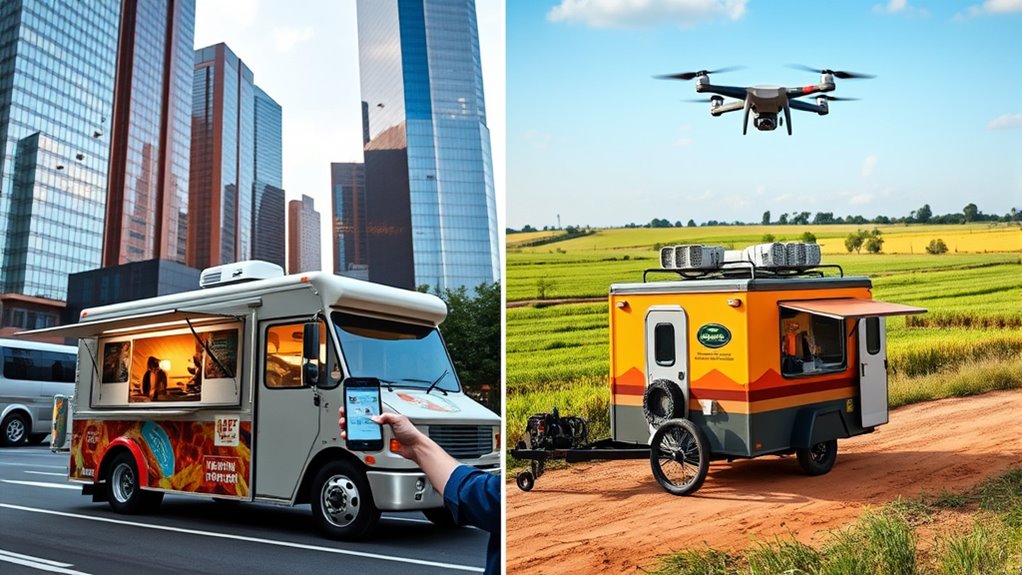
Leveraging technology is essential for streamlining food truck operations and boosting overall efficiency. Digital payment systems simplify transactions, reduce wait times, and improve customer satisfaction, whether you’re in a busy urban area or a remote rural setting. By offering multiple payment options, you cater to diverse customer preferences and minimize cash handling risks. Social media is another powerful tool; it helps you promote your location, daily specials, and events in real time. You can engage your audience, gather feedback, and build a loyal customer base without geographical constraints. Integrating these technologies enables you to operate more smoothly, save time, and adapt quickly to changing conditions, giving you a competitive edge regardless of your environment.
Frequently Asked Questions
How Do Weather Conditions Impact Food Truck Operations Differently in Urban and Rural Areas?
Weather impact can considerably influence food truck operations, causing delays and disruptions. In urban areas, rain or snow may lead to traffic delays, making it harder to reach customers on time. In rural areas, extreme weather like storms or high winds can close roads or damage equipment, stopping service altogether. You need to plan for these weather impacts, adjusting your schedule and routes to minimize delays and keep your business running smoothly.
What Are the Best Practices for Building Community Relationships in Rural vs. Urban Settings?
Research suggests that effective community engagement and partnership building vary between urban and rural settings. In urban areas, you should leverage social media and local events to connect, while in rural communities, face-to-face interactions and supporting local initiatives foster trust. Building relationships in both contexts involves understanding community needs, showing genuine interest, and maintaining consistent presence. Adapting your approach ensures stronger bonds and long-term support, regardless of location.
How Does Local Culture Influence Menu Choices in Different Environments?
You’ll find that local culture shapes your menu choices by influencing cultural preferences and expectations. In diverse urban environments, you should offer menu diversity to cater to varied tastes, incorporating international flavors and trendy options. In rural settings, focus on traditional, locally loved dishes that resonate with community values. By understanding these cultural preferences, you can create a menu that appeals to your target audience, boosting satisfaction and loyalty.
What Safety Concerns Are Unique to Urban Versus Rural Food Truck Locations?
Imagine parking your food truck in busy downtown, where traffic congestion and parking restrictions are common. You need to guarantee safe loading zones and avoid accidents. In urban areas, safety concerns include managing traffic congestion and strict parking rules, which can cause delays or hazards. Conversely, rural locations pose risks like limited security and emergency access. Staying aware of these unique safety issues helps you keep both your customers and your team safe.
How Can Food Trucks Adapt to Varying Internet Connectivity Levels Across Regions?
You need to focus on digital adaptation to guarantee your food truck stays connected across regions with varying internet quality. In areas with poor connectivity, invest in offline-capable point-of-sale systems and backup solutions like mobile hotspots. Use connectivity solutions such as signal boosters or satellite internet where necessary. By proactively adapting digitally, you can maintain smooth operations, process orders efficiently, and provide a seamless customer experience regardless of regional internet challenges.
Conclusion
As you navigate the complexities of food truck logistics, one critical factor remains hidden just around the corner—your next big opportunity. Whether you’re in a bustling city or a quiet rural area, the right strategies can uncover untapped potential. But what challenges will you face next? Stay prepared, adapt quickly, and keep your eyes open—because the key to success might be closer than you think, waiting to transform your approach when you least expect it.


